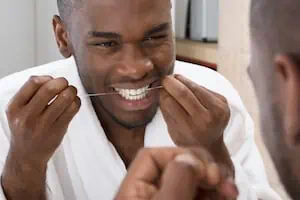A dead tooth can happen to the best of us and it can happen in a variety of ways.
Maybe you were in a bike accident and a few days later you noticed your front tooth turning gray. Or perhaps you haven’t been practicing a proper oral hygiene routine and one day you notice a foul odor emanating from your mouth, accompanied by discoloration.
Trauma and decay can cause your teeth to die, and in the process, your tooth may turn gray, your breath may smell bad, and you might experience extreme pain.
While having a dead tooth can be a bit scary, don’t worry—dead tooth treatment is a fairly common procedure that your dentist should be able to perform without any problems. It is, however, important that you not ignore symptoms and make sure to see your dentist so you can do right by your dental health
If you are concerned about dead teeth, keep reading and you’ll learn all about the causes, symptoms, and treatment for this problem so you know what to expect if it happens to you.
What is a dead tooth?
A dead tooth, also known as a non-vital tooth, is a condition in which an internal or external factor disrupts the active blood supply of a tooth. The tooth becomes weak and can fracture easily.


Our teeth are composed of three layers: enamel, dentin, and pulp. The pulp forms the innermost section of a tooth and is a rich source of blood vessels and nerves. These healthy blood vessels and nerves play a significant role in the adequate nourishment of the tooth. A tooth is said to have died when its vessels and nerves die due to trauma, damage, or decay.
What happens when you have a dead tooth?
The implications of a dying tooth extend far beyond mere discoloration. In addition to discoloration and toothache, some of the most common symptoms associated with a dead tooth are listed below:
- Toothache
- Loss of sensation
- Tooth discoloration; a gray or black tooth
- Swelling, abscessing/infection
Nerve death
As mentioned above, nerve death happens when the nerves in a tooth’s pulp become damaged and gradually begin to degrade. Destruction of the nervous tissue inside the tooth also causes blood vessels to degenerate. When this happens, the affected tooth loses its nerve supply and becomes prone to decay, infection, and even fracture.
So how long does it take for a nerve in a tooth to die?
The time it takes for a nerve in a tooth to die is different for everyone. It can take a few days or it can take years. Even if it happens slowly, if you notice that your tooth is changing color and you suspect your tooth’s nerve is dying, you should visit your dentist immediately.
Toothache


One of the most common symptoms of a dead tooth is consistent pain that extends into the gums. In most cases, the pain is constant butin some cases, it may be transient. Such tooth nerve pain is due to an increased pressure build-up inside the tooth due to pulpal inflammation.
The pain has multiple aggravating factors such as cold, hot, or sweet food, and is usually relieved by over-the-counter painkillers. Sometimes, the pain related to a dead tooth is so intense that it may keep you up at night. For more information on toothaches, you can read our complete guide here.
Increased sensitivity
Increased tooth sensitivity is an indication of dying, inflamed pulp tissue. The sensitivity occurs as sharp pangs in one tooth at a time when exposed to sweet, cold, or hot foods or during flossing in some cases. The sensitivity tends to intensify with time, especially in untreated cases. However, teeth tend to lose their sensitivity once the pulp is completely dead.
Infection/abscessing
The dying soft tissue in the tooth, especially in the pulpal region, is highly vulnerable to bacterial infections. Because of the limited space of the tooth, the infection directly compresses the hard dentine walls, eventually triggering extreme bouts of pain. If left untreated, small pockets of pus called abscesses may form.
Infection of dead teeth is extremely dangerous because it can spread to other tissues. It can cross the root canal and spread into the jaw bone. In some cases, the infection can travel to the respiratory system and cause a serious, life-threatening condition.
Additional symptoms of a tooth abscess include:
- Foul breath
- A bad taste in the mouth
- Fever
- Swelling in the cheek
- Swelling of lymph nodes in neck and jaw
- Discomfort while chewing
- Difficulty in swallowing/breathing
Tooth discoloration
If you have a tooth turning black or even only slightly gray teeth, it may indicate dead tooth nerves and a hindered blood supply and poses a threat for imminent tooth death. The discoloration found in gray teeth due to nerve death is completely different from coffee, tea, or tobacco stains, so it is easy to distinguish between the two conditions.
A black or gray tooth emerges as a sign of trauma-induced death of the tissues in the pulpal cavity. It typically takes several weeks to develop and occurs as the pigments formed during the breakdown of pulp tissue are released into the dentin.
What causes a dead tooth?
If your teeth are turning from white to black or grey, you’ll likely want to know the causes. There can be two main reasons that may cause death in otherwise healthy teeth.
Tooth decay/ dental caries


Dental caries refer to the destruction of the outer surface of the tooth as a result of bacterial infection. It’s important to see your dentist because they’ll know how to stop tooth decay from spreading.
Untreated tooth decay can lead to the formation of teeth cavities, which eventually extend to the pulpal layer of the tooth, carrying the infection into the tooth’s interior. A healthy pulp is able to fight off any bacteria that dental caries bring in. However, this causes the pressure inside the pulpal cavity to gradually increase. When the pressure gets too high, the blood supply is completely cut off leading to the death of the tooth.
According to the World Health Organization, oral diseases affect more than half of the world, and dental caries occurring in permanent teeth is the most prevalent of these oral diseases. A high prevalence of dental caries across the world automatically increases your risk of acquiring a dead or grey tooth.
According to a survey conducted by the National Institute of Dental and Craniofacial Research (NIDCR), a large number of people in the US carry dental caries in their permanent teeth. The statistics are alarming, with the highest prevalence (95.62%) of dead teeth in the older age group, as shown in the table below.
Age group | Prevalence of caries |
24-34 years | 85.58% |
35-49 years | 94.30% |
50-64 years | 95.62% |
Trauma to the tooth
Even if you are careful enough to maintain good dental hygiene, you may not be able to fully escape a dead tooth. Trauma, such as a hard fall or a sports injury, is another reason why a tooth can die. Such types of physical trauma cause the blood vessels inside the dead teeth to rupture, leading to poor blood supply. It can also cause nerve injury and damage the pulpal tissue leading to inflammation and infection.
Can a dead tooth be saved?
If you have a tooth that has died as the result of tooth decay, you’re probably wondering how to fix a cavity so your tooth can be saved. Saving a dying tooth is possible if a timely diagnosis is made. The process to save a damaged tooth, known as a root canal, can help the tooth recover without the need of alternative treatment (i.e., extraction).
Root canal treatment
Root canal therapy is performed by dentists to save a decaying tooth while keeping it intact. During the root canal procedure, your dentist will drill a small hole in the affected tooth, remove theinfected pulp tissue, and then clean and disinfect the interior.
Once the infected pulp is cleared out, your dentist will use an inert material to completely seal the roots, which prevents re-entry of the infection. Once complete healing has taken place, the dentist will place a permanent filling to restore the tooth.
In cases where the damage has extended to the enamel, your dental professional may suggest adding a crown following a root canal. Sometimes, even after receiving a root canal, a dead tooth can become brittle. This is why a crown molded to your tooth is often permanently fitted.
The use of crowns also ensures that the discoloration is well-hidden and is unnoticeable. If your dentist does not use a crown, the discoloration can be hidden using a tooth bleaching agent. Alternatively, a porcelain veneer may also be used to cover the affected tooth. It is best to talk to a professional regarding the suitability of different aesthetic treatments.
You can watch the following video to learn more about the procedure and hopefully calm any anxiety you may be feeling if you need to have this procedure done.
If you think you may need a root canal and need to find an endodontist, we have an article that can help you find an endodontist near you.
Extraction
Tooth extraction is a permanent and relatively painless mode of treatment for a dead tooth. Your dentist will use local or general anesthesia before starting the process. During extraction, the dead tooth is tightly gripped using the appropriate equipment and pulled from its base. If the tooth is well-impacted into the gums, the dentist may prefer breaking it up into smaller pieces before completely removing it. Rest is usually advised following the surgery.
To minimize the post-operational pain, using ice packs is recommended. You should also only eat soft foods that do not irritate the extraction site, at least for a few days. In most cases, alcoholic beverages and fizzy drinks are strictly prohibited for at least a week following the procedure.
Following an extraction, your dental professional may replace the dead tooth with a denture, bridge, or implant. It is important to discuss your options with your dentist. The following questions should be asked during the session:
- How much will the replacement cost? Will it be covered by my insurance?
- Will I need to replace it frequently?
- What should I expect regarding recovery?
- Are there any special instructions about dental care after this replacement?
- How long should I have my mouth guard on?
Preventing a dead tooth
With proper care, it is certainly possible to prevent a dead tooth from recurring in the future. To avoid getting into a tooth emergency ever again, follow the tips below:


- Before playing sports or participating in an activity with high chances of physical trauma, remember to wear a mouth guard or a gum shield. In the case of trauma, get a dental checkup as soon as possible.
- Schedule regular appointments with the dentist. The dentist will decide the frequency of your visits according to the current health status of your teeth, gums, and oral cavity.
- Avoid foods and beverages rich in sugar and starch, especially between two consecutive meals and close to bedtime. It is important to remember that certain medications also contain sugar, among other ingredients. Take care to use sugar-free alternatives whenever you can to avoid cavities.
- Take care of your gums and teeth properly. Brush your teeth thoroughly twice a day using a fluoride-rich toothpaste. Don’t forget to floss at least once daily.
- Dry mouth may occur due to certain medical treatments, medicines, or underlying diseases. Always consult a GP or a dentist regarding this complaint.
- There is a strong association between the use of tobacco and the prevalence of oral diseases. Therefore, quit smoking as soon as you can.
There is no single method that guarantees that you will never experience a dead tooth in the future. However, these preventive measures can substantially reduce the risk.
Conclusion


A dead tooth is a highly prevalent problem with a tendency to cause a great deal of damage to your overall oral health. It can produce extremely uncomfortable symptoms like increased sensitivity, a constant toothache and discoloration.
In a worst-case scenario, the infection may spread to other teeth, and even to the jawbones, producing unnecessary complications.
While procedures like a root canal or dental extraction can help alleviate the symptoms, it is better to prevent the problem altogether by following the tips mentioned above.
FAQs
Why does a dead tooth become infected?
As the nerve inside a tooth is damaged, your immune system detects it as a foreign body. It, therefore, initiates several defense mechanisms that infiltrate the damaged tooth. These eventually result in excessive inflammation around the tooth, especially the root. As they come into contact with saliva, the bacteria get transferred into the rotting tooth leading to an infection.
What can you do to manage pain associated with a dying tooth?
A dead tooth with cavities can be extremely painful to handle. However, with proper measures, it is possible to considerably reduce the pain. Follow these steps to help:
- Avoid drinking hot beverages, as they increase the inflammation and worsen the pain.
- Consider using an over-the-counter anti-inflammatory medicine, such as ibuprofen
- Avoid eating tough foods as you may require extra pressure to chew them which will aggravate the pain.
How often should I visit the dentist to prevent tooth death?
The frequency of dental appointments usually varies from person to person. Your dentist decides the frequency of these visits based on the current status of your oral health. However, as a rule of thumb, you should visit your dentist at least every six months to prevent and diagnose developing tooth problems, in their early stages before permanent damage occurs.
Can a dead tooth spread?
Yes, the infection from a dead tooth can spread to the surrounding teeth if left untreated. This occurs as the bacteria from the dead tooth enter the surrounding healthy teeth and damage them. In severe cases, the infection may reach the gums and jawbone, causing massive complications.
How long does it take for a tooth to die?
How long it takes for a tooth nerve to die depends on the intensity of trauma and/or the extent of dental decay; a tooth can take a few weeks to several months to completely decay. The exact time period cannot be determined as it varies from person to person.
How long can a dead tooth stay in your mouth?


If you suspect you have a dead tooth, either due to pain, smell, looseness or having a darker hue than the rest of your teeth, it’s imperative that you seek treatment from your dentist. They will advise you of the best course of treatment, usually either a root canal or extraction, but you can be sure that they won’t offer you the option of keeping the dead tooth in your mouth as it is.
That’s because a dead tooth can harbor bacteria which can eventually cause infections in other teeth, and even spread to your jaw, causing problems with not just your mouth, but your overall health.
Does a dead tooth smell?
A dead tooth can smell in some cases, creating a foul taste in your mouth or particularly bad breath. However, sometimes the smell develops gradually, so you might not even be aware. That’s why it’s important to pay attention to all of the signs that suggest you may have a dead tooth, like color and pain.
Will a tooth root come out on its own?
A dead tooth will eventually fall out on its own, but you absolutely should not wait for this to happen. If left untreated, a dead tooth can lead to serious complications. These can include infection and excruciating pain. Additionally, it’s not guaranteed that when the tooth falls out the root will come with it.
How can I prevent a dead tooth?
Dead teeth mostly happen because of trauma, injury, or infection – prevent these and you won’t have to worry about a dead tooth. Ensure optimal oral hygiene through regular brushing and flossing. Also, make sure to wear a mouthguard if you are involved in contact sports.
NCBI: Dental Abscess. Consulted 19th December 2019.
American Association of Endodontists: Root Canal Explained. Consulted 19th December 2019.
NIDCR: 2000 Surgeon General’s Report on Oral Health in America. Consulted 19th December 2019.
Mouthhealthy: Decay. Consulted 19th December 2019.
NCBI: Pulpal response after acute dental injury in the permanent dentition: clinical implications-a review. Consulted 19th December 2019.
NIDCR: Dental Caries (Tooth Decay) in Adults (Age 20 to 64). Consulted 19th December 2019.
WHO: Oral health. Consulted 19th December 2019.




